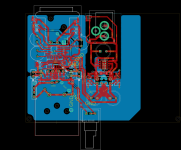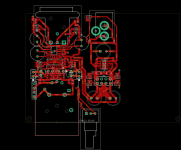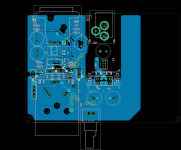Hi!
In my experience with buiding a low noise pre-amp for a ribbon mic, as we decrease input impedance, high frequencies indeed are killed first.
But, above 10kOhm input impedance, it makes not much difference. Below 4.7kOhms we clearly can see the difference showing up.
See attached some measurements I've done some years ago comparing different input impedance values versus the baseline of 10Mohm input impedance.
10k, 4,7k, 2.2k, 1k and 560Ohms. Charts zooming 10 to 10kHz, 100 to 10kHz, 1k to 10kHz and 4kHz to 10kHz so as to better observe the frequency response in each range.
These measurements must be observed from the relative perspective: same mic, same pre-amp circuit and same loudspeaker. The only variable changed was the insertion of a resistor at the input so as to vary the input impedance.
I ended up building this pre-amp with 2 pairs of JFET LSK389 (parallel to reduce noise) with 100kOhm input impedance to gnd.
Thanks for sharing those, that's really interesting to see! I wonder if older mics with a lower output would start to get loaded even sooner.
How did you solve the current sinks when you built it?
No worries, thanks for the suggestions!Hi Tashi1, Hope you are not offended but I would prefer not to share the final schematic of my design.. as I now started to build these and offer them as a "commercial" product.
But the preamp is performing in Class A , push-pull and drives a small signal transformer at its output. The LSK series is well suited because of the matching of the pair of FETs, and they are indeed very quiet. I went for about 24 dB of gain (variable feedback) and at full gain the noise floor is super low, I think better than 110 dB signal to noise ratio. For instrument levels I felt that 0 to 24dB is more than enough range for the gain. The transformer is not a super high end, though good enough for guitar and bass etc for the frequency response.
I have also tested it with higher end output transformer with very good results. For your mic /instrument preamp, you'd probably want to use something like the Jensen, Cine-Mag or Hammond studio series transfos. They are pricey but you'll get full audio bandwidth , balanced and isolated signal for DI applications.
If I were doing a preamp that would work for both mic and instrument, I would probably try to optimize the mic preamp front end separately from the instrument front end and merge the two at the middle or output section. You definitely don't "need" 60 dB of gain for the instrument level.
Cheers!
Yes figuring out the sinks to operate perfectly is probably beyond me at this stage, I'll start with the easier on-chip route for nowThe original post showing Bob Cordell's proposed design seems pretty reasonable to go with. It's not exactly a complete circuit, as it is showing the LSK 389/489 as an open input +/- differential pair. It is also leaving the current sinking parts as a black box..so you need to design that aspect.
A similar mic preamp design by Elliot Sound Products (Project 66) for low noise balanced microphone preamp, but uses bipolar transistors in the front end differential amplifier. I'd suggest having a look at that one to get some direction on tying in the differential pair +/- inputs to the microphone...for input impedance and grounding. Also the power supply to the first and second amplification stage should be very well regulated.
ESP Project 66 low noise mic preamp
Cheers
Drew this up, INA163 with 1646 as a line driver. Ability to use jumpers to select a different input impedance & also bypass the phantom caps (that's a particular use-case for me - sometimes I need to split a mic output that is carrying phantom).
INA163 should give about 7-75dB, then another 6dB from the 1646. Sorry its a bit messy. Any glaring issues?

PSU circuit. U3 is a BUF634 as a rail splitter, J7 is a DC input jack. Ability to use jumpers to input a proper dual rail supply

INA163 should give about 7-75dB, then another 6dB from the 1646. Sorry its a bit messy. Any glaring issues?
PSU circuit. U3 is a BUF634 as a rail splitter, J7 is a DC input jack. Ability to use jumpers to input a proper dual rail supply
Hi, I used the popular current source as shown below to sink current from the JFET differential amp.How did you solve the current sinks when you built it?
You build a voltage divider (10K and 4.7k) so you get a certain fixed voltage at BC549 base (in this case 4.8V above the -15VDC).
This voltage, minus 0.6V, will be applied to the 1k resistor (4.2V) which forces 4.2mA on the emitter.
The emiiter current will be reflected to the collector of BC549, thus you get a fixed current source in the BC549 collector.
Any glaring issues?
94 second charging time constant for C11 and C12 when the preamplifier is set in high-impedance mode. You will have to be patient after turning on the phantom supply.
Working voltage of C1 and C2 just too low to survive a 48 V +/- 4 V phantom supply when there is no microphone connected and the voltage happens to be at the higher side of the tolerance interval
0.8 pA/√Hz input noise current is fine for microphones, but may be a bit high if you still want to connect electric guitars. Then again, maybe it's no big deal, as I have been told that electric guitars usually pick up enough mains hum to mask the noise.
On the Project 66 circuit? Was it open at the input, and what frequencies of oscillation?Yesterday, I simulated the design in LTspice and I wasn't able to remove an oscilation that seems to have its origin in the input stage.
Now that I use the NE5532 the oscillation has vanished even when using with the combination of 2N3904/2N3906.
Before, I used the LT1028 and the OPA1656 and with both I had an oscillation.
As these two are high bandwidth opamps I may try some other newer opamps with a lower GBP.
Before, I used the LT1028 and the OPA1656 and with both I had an oscillation.
As these two are high bandwidth opamps I may try some other newer opamps with a lower GBP.
Last edited:
Hi, I used the popular current source as shown below to sink current from the JFET differential amp.
You build a voltage divider (10K and 4.7k) so you get a certain fixed voltage at BC549 base (in this case 4.8V above the -15VDC).
This voltage, minus 0.6V, will be applied to the 1k resistor (4.2V) which forces 4.2mA on the emitter.
The emiiter current will be reflected to the collector of BC549, thus you get a fixed current source in the BC549 collector.
Ahh I see, thanks that works perfectly in the simulator! It seems you can add more gain by increasing the current? Is a fancy low noise transistor required in this position?
Looking at the sink in a phono pre Cordell did he uses two transistors like this, I wonder what the advantage is:
Thanks, I missed the 50V rating!94 second charging time constant for C11 and C12 when the preamplifier is set in high-impedance mode. You will have to be patient after turning on the phantom supply.
Working voltage of C1 and C2 just too low to survive a 48 V +/- 4 V phantom supply when there is no microphone connected and the voltage happens to be at the higher side of the tolerance interval
Charging time doesn't matter, the caps are only for protection from external voltage.
Good point, the FET in my first post would be a lot quieter, I'll build that too eventually.0.8 pA/√Hz input noise current is fine for microphones, but may be a bit high if you still want to connect electric guitars. Then again, maybe it's no big deal, as I have been told that electric guitars usually pick up enough mains hum to mask the noise.
Good to know! Changing the current, will change the bias point, the gain and also the noise. You have to look at the datasheet info to find the best point.Ahh I see, thanks that works perfectly in the simulator! It seems you can add more gain by increasing the current?
You don't need much gain in the first stage. If you need more gain to your pre-amp, let the next stage to do it, which doesn't need to be super low noise.
In a chain, the first stage is key to define the total S/N.
In my case, I used the very cheap and popular BC549.Is a fancy low noise transistor required in this position?
What really makes the difference is the first stage differential JFET pair and you are using top notch devices.
I don't know what is the advantage of using 2 BJT's in the current source topology. Interesting to research!Looking at the sink in a phono pre Cordell did he uses two transistors like this, I wonder what the advantage is:
I think a separate instrument input stage for guitar/bass could be better to optimize the preamp, just IMHO.Then again, maybe it's no big deal, as I have been told that electric guitars usually pick up enough mains hum to mask the noise.
Hi Tashi, with regards to an instrument preamp input, I have discussed some different amp topologies on other threads here, and one that could be of interestGood point, the FET in my first post would be a lot quieter, I'll build that too eventually.
would be a Bifet arrangement. For single ended (unbalanced) input and moderate gain of 20 to 30 dB. Basically using a JFET and direct coupled (PNP) BJT along with a feedback network. So you have a high input impedance of the Jfet which guitars get along with, and probably more than enough gain going to your preamp output section. The overload characteristics are "nice" so if you have some signal peaking it shouldn't do so too harshly.
I feel a bit bad not fully sharing my JFET preamp circuit design with you, but just to say that your mic preamp circuit already has a balanced out driver, so really it's the unbalanced instrument input section and single ended output that you can merge into your existing circuit.
I'll dig up some examples of BiFet amp stages, and post them if you're interested. Cheers!
This is a basic JFET-PNP compound amplifier, from Fairchild Semi AN-6604 application note. There are other similar circuits around. In this case for an instrument preamp 1M instead of 10 M input resistance would be suitable. Would probably use an input capacitor on this circuit to de-couple any potential DC from the source, but it would work direct in from a pickup. I have also seen a capacitor placed across R2 to limit Hi Frequency gain, around 200 pF. R2 could be increased to 47K for an overall gain of about +33 dB which might be too much , depends what your subsequent gain staging looks like.
I breadboarded this circuit a long time ago, not sure which JFET I used, but I think common 2N5457 would work. Cheers!

I breadboarded this circuit a long time ago, not sure which JFET I used, but I think common 2N5457 would work. Cheers!
- Home
- Live Sound
- Instruments and Amps
- High impedance mic preamp design


